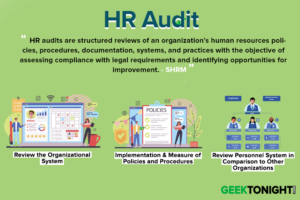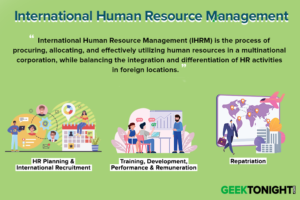What is Manpower Planning?
Manpower planning, also known as workforce planning or human resource planning, is the process of strategically analyzing and forecasting an organization’s current and future staffing needs. It involves assessing the organization’s objectives, understanding its current workforce, and determining the optimal workforce structure to achieve its goals effectively and efficiently.
When the two terms manpower and planning are combined, a process is driven that helps in identifying the right number of people with the right skills for the right jobs in an organisation. Manpower planning is a systematic process that identifies and assesses human resource requirements in an organisation to achieve its goals and objectives. It is also known as human resource planning (HRP).
Table of Content
- 1 What is Manpower Planning?
- 2 Manpower Planning Definitions
- 3 Objectives of Manpower Planning
- 4 Levels of Manpower Planning
- 5 Behavioural Factors Affecting Manpower Planning
- 6 Process of Manpower Planning
- 7 Organisational Development and Manpower Planning
- 8 Organisational Culture and Manpower Planning
- 9 Pre-Requisites of Manpower Planning
- 10 Difficulties in Manpower Planning
- 11 Organisational Culture and Manpower Planning in Southwest Airlines
Manpower Planning Definitions
The following are some important definitions of manpower planning:
According to Vetter, manpower planning “is the process by which management determines how an organisation should move from its current manpower positions to its desired manpower position.”
According to Decenzo and Robbins, manpower planning “is the process by which an organisation ensures that it has the right number and kind of people, at the right place, at the right time, capable of effectively and efficiently completing those tasks that will help the organisation achieve its overall objectives.”
Manpower planning plays an important role by helping an organisation in:
- Determining the future human resource requirements and meeting them.
- Preventing the surplus or shortage of manpower.
- Identifying the skills and competencies of human resource for a particular job.
- Monitoring and controlling various HR activities, such as selection, training and performance appraisal.
- Striking a balance between the demand and supply of human resource in order to better respond to the changes in the business environment
Objectives of Manpower Planning
The goal of manpower planning is to estimate the required number of human resource so that the pre-defined goals and objectives of an organisation can be achieved successfully.
In this regard, manpower planning aims to meet the following objectives:
- To predict the future human resource requirements: Manpower planning makes plans for identifying the required number of personnel in the future. This forecasting helps an organisation to fill vacant positions and hire the right people for the right positions at the right time.
- To handle organisational changes effectively: Manpower planning makes plans for managing organisational changes related to the market, technology or government regulations by preparing human resource for such changes.
- To use the existing human resource optimally: Manpower planning aims to optimally use the current human resource for meeting job requirements. The current personnel are more experienced than new employees. By using them optimally to fill vacant positions, an organisation can save costs related to salary and training.
- To promote employees in a systematic manner: Manpower planning intends to evaluate current personnel in an organised way. It communicates accurate information about employees’ skills to the management, which helps in promoting employees on a reasonable basis.
Levels of Manpower Planning
Manpower planning is mainly done at two levels, namely micro-level planning and macro-level planning. The difference between the two types of planning lies in the scope of coverage. These two types of manpower planning are explained as follows:
Micro-Level Planning
This type of planning is conducted at narrow level that focuses on estimating the manpower requirements of in individual organisations. It helps an organisation to critically analyse its occupational and procedural levels. Manpower planning at a micro level involves three main steps,
which are as follows:
- Analyse the demand of human resource
- Analyse the supply of human resource
- Evaluate the gap between the two
Macro-Level Planning:
This planning is conducted at a broader level that encompasses determining manpower requirements of specific industries. This planning helps organisations to determine the on-going demand and supply of manpower, compensation grades, etc. in the industry.
Behavioural Factors Affecting Manpower Planning
Whether it is about bridging HR gaps or aiding HR activities, manpower planning deals with the behaviour of people. Human beings are unique and no two people have the same behaviour. Even twins have different behaviour, attitude, personalities and traits. It is essential that an organisation understands these behavioural differences of employees and helps them to develop a positive attitude towards work. For this purpose, an organisation can consider the following behavioural factors, which shape its manpower planning:
Personality
These are the characteristics or traits that an individual displays, such as extroversion, introversion, timidity, confidence and consciousness. These personality traits are mostly inflexible. Therefore, instead of changing an individual’s personality, many organisations try to recruit those people whose personality fits the job. For this purpose, the organisation can use various psychometric tests and tools.
Attitude
It is a way in which an individual reacts towards something or some situation. In other words, attitude is a consequence of an occurrence and it develops with time. It is relatively difficult to change an individual’s attitude. However, communication can help the individual to change its attitude to some extent.
Values
These are the most important beliefs and requirements of an individual. Values include needs, desires, interest, social and religious learning, education fundamentals, and moral thinking. An organisation can teach its basic organisational values to employees to bring a sense of belongingness.
Process of Manpower Planning
Manpower planning is one of the most significant processes of HR practices. It helps in forecasting the future human resource needs of an organisation. It also ensures the proper implementation of HR practices and procedures in the organisation.
The manpower planning process follows a sequence of steps are:
Environmental Supervision
An organisation starts manpower planning by first scanning the external environment of a business. This helps the organisation in collecting and analysing factors that influence the organisation’s progress.
Deriving Organisational Objectives and Policies
After analysing the external environment, the organisation should derive specific requirements in terms of the number and characteristics of employees from organisational objectives. The organisation then prepares HR plans according to these organisational objectives. HR plans in turn help the organisation to develop policies related to HR activities.
Some important HR activities include:
- Determining the source of recruitment (internal or external)
- Designing a plan to motivate and retain human resource
- Developing various modes of downsizing to ensure organisational competitiveness
- Developing job enrichment techniques to improve job satisfaction of employees
- Developing a routing programme for shifting employees to other process in order to avoid monotony in a single job
- Designing innovative programmes to train and develop employees
Demand Forecasting
It involves estimating the number of human resource and skills required in the future to meet organisational objectives. Demand forecasting helps in:
- Evaluating human resource requirements in different departments of an organisation.
- Preventing the shortage and surplus of manpower
While forecasting the demand for human resource, the organisation considers various external and internal factors, such as level of competition in domestic and international markets, budget, economic conditions, technological changes and production level.
Supply Forecasting
This technique is used to estimate the future availability of human resource with the required skills and competencies. Supply forecasting helps the organisation to estimate the existing number of employees in different departments and avoid the shortage of manpower. To forecast the supply of human resource, the organisation considers various factors, including absenteeism, the rate of attrition, internal job rotation, promotions and change in work hours.
Human Resource Programming
After estimating the demand and supply of human resource, the organisation develops action plans to identify and bridge gaps between demand and supply. This stage of reconciling or balancing the demand and supply of manpower is called HR programming (HRP). The formulated action plans help to fill vacancies by the right employees at the right time. These action plans also help to increase or decrease the number of employees according to the demand and supply of human resource in the organisation.
An organisation can implement various measures to prevent the shortage or surplus of human resource, such as recruiting or downsizing employees, providing incentives for postponing or early retirement, hiring employees on a contractual basis, subcontracting or undertaking new contracts and so on.
HRP Implementation
After formulating HR plans, the organisation converts these plans into action. This implementation process helps to test the reliability and feasibility of HR plans.
Figure illustrates some action programmes that constitute the HRP implementation process:
HRP Controlling and Evaluation
This stage represents the final stage of the manpower planning process. The HR plan should include budgets, targets and standards. It should also outline responsibilities for implementation and control and establish reporting procedures that enable the organisation to monitor achievement against the plan.
Organisational Development and Manpower Planning
The two concepts manpower planning and organisational development are closely related to each other. Organisational development aims at improving the overall performance of an organisation through its employees. Organisational development can also be called change facilitation, which helps organisations in delivering sustainable performance.
Organisational development aims at making required changes in an organisation’s environment. It is basically a human resource development approach that is used for problem solving and process renewal. Organisational development requires the total effort and commitment from the employees of an organisation.
The role of organisational development in efficient manpower planning is explained as follows:
- Organisational development enables the HR department in improving existing systems (human and/or mechanical) and making them capable of performing their future roles.
- Organisational development helps in creating a culture of openness and belongingness where the superior-subordinate role is more democratic and less authoritarian.
- Organisational development helps employees to develop an overall personality and also make the best utilisation of their hidden talents.
Organisational Culture and Manpower Planning
In present times, it has become essential to understand the factors that influence the performance of employees, such as organisation’s culture, motivational forces and needs of employees. Among all the factors, an organisation’s culture plays a dominant role in building its image among its employees, stakeholders and competitors. Therefore, a feeling of respect based on values, commitment, success stories, vision, mission and goals is inculcated among employees through organisation culture.
Organisational culture, also known as corporate culture, comprises norms, values, and unwritten codes of conduct shared by the employees of an organisation. Every organisation has a distinct and unique culture that acts as a guide for employees by defining the standards of acceptable behaviour. Moreover, by fostering a developmental approach in organisational climate, organisation culture lays a strong foundation for manpower planning.
The following points show how manpower is affected by the organisation’s culture:
- An organisation’s culture defines the degree or level to which employees can freely share their ideas, willingly take risk, and accept continuous learning.
- It also defines the level of comfort that employees share while resolving issues in the work environment.
- It helps in developing trust among employees in the organisation.
- It helps in team building and making the best possible use of everyone’s capabilities.
Pre-Requisites of Manpower Planning
The effectiveness of the human resource management (HRM) function of an organisation depends on the success of its manpower planning process. However, an organisation cannot envisage the accuracy of the manpower planning process at an early stage. Therefore, the organisation should consider certain pre-requisites of the manpower planning process to ensure the process accuracy.
These pre-requisites are as follows:
- Identify manpower planning as an important part of corporate planning.
- Understand corporate objectives.
- Gain support from the top management.
- Review and revise techniques of data collection, analysis and forecasting on a periodic basis.
- Ensure the synchronisation of the HR department with the other departments of an organisation.
- Ensure consistency and accuracy of data required to formulate HR plans.
Difficulties in Manpower Planning
As discussed earlier, manpower planning is used by organisations to estimate and deploy human resource efficiently in an organisation. However, sometimes this process is ineffective due to various difficulties, which are as follows:
Vague and Ambiguous HRP Objectives
An organisation may fail to identify the need and importance of HRP. Many organisations tend to consider the HR department as just a business unit dispensing salaries to employees. However, the role of the HR department is much more than that. Apart from this, there are many other organisations having a view that initiatives, such as career planning, succession planning, and employee satisfaction, are redundant activities; therefore, investment should not be made on such activities. All of these events lead to ambiguity in the HRP objectives in organisations.
Limited Role of Top Management
If the management is playing a limited role in the design and implementation of the manpower planning process, the planning of HR programmes comes to a standstill. In some cases, the top management is unable to communicate the exact requirement of human resource to HR planners. To prevent such a situation and make the manpower planning process successful, the top management of the organisation must support HR planners.
Lack of HR Planning
If HR planning is inadequate, HR planners estimate inaccurate human resource requirements. Sometimes HR planners fail to recognise the significance of job description and specification. As a result, they select wrong and unsuitable candidates for the job. Therefore, for a successful manpower planning, the HR planners need to analyse human resource requirements accurately.
Ineffective Strategic Planning
An organisation must combine HRM with strategic planning as the skills and performance of human resource play a significant role in achieving strategic objectives. If an organisation fails to do so, the HRP process fails.
Organisational Culture and Manpower Planning in Southwest Airlines
“Southwest works because people pull together to do what they need to get a plane turned around. That is part of the Southwest culture. And if it means the pilots need to load bags, they’ll do it.”
Harold Sirkin
Attending to employee’s grievances and issues are extremely critical to the success of any organisation. Redressing such issues consume a substantial amount of time and resources of an organisation. Southwest Airlines is a classic example, wherein competitive and motivating organisational culture helps the organisation to successfully retain its employees. In 1971, Southwest started its operations with just 198 employees. However, the journey was not very easy.
Different competitors, including Continental Airlines, used various means to ensure that Southwest could not start its operations. In 1994, the Southwest, the United, and the Continental Airlines entered into fierce competition. However, the “low fare, no frills” air service offered by Southwest left the other two far behind in the competition. Though a few competitors, such as Continental Lite, started adopting a similar strategy to compete with Southwest, but none of them was successful in denting the market share of Southwest Airlines.
The main reason behind the failure of other airlines was that none of them had a people-oriented organisational culture like Southwest. United Airlines was suffering from inter-organisational conflict; whereas Continental Lite was not employee-centric. The major reason behind the success of Southwest Airlines was its organisational culture which used to focus on leveraging its employees to gain a competitive advantage. The low-cost strategy is something that Southwest’s competitors were able to imitate.
However, they failed to consider the immense loyalty of its employees. Southwest has an employee-centric organisational culture that helps in motivating the employees to mix work with fun, which in turn has resulted in delivering excellent service to customers. Southwest possesses a highly competent and productive workforce. The efficiency of its workforce has helped Southwest in achieving a turnaround time of just 15 minutes, whereas the industry average is of 35 minutes.
Compared to the industry average (130 employees), Southwest deploys 40 per cent fewer employees (81 employees) in an aircraft. The organisational culture in Southwest is driven by the philosophy, namely, “Work is important…don’t spoil it with seriousness”. The people-based and supportive organisational culture has made the human resource department of Southwest to be named as the “people department”. The department emphasises on two Cs – Compassion and Common Sense. Southwest also encourages its employees to “break the rules” whenever necessary.
Other organisational philosophies include:
- Treating employees as its internal customers.
- Aligning employees with the organisational goals, values, culture and systems.
- Maintaining consistency at different levels of management, in reinforcing organisational values and culture.
- Providing the same opportunities to the employees in learning and personal growth.
- Focusing on continuous internal improvement rather than on competitors.
Human Resources Tutorial
(Click on Topic to Read)






